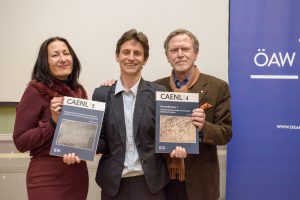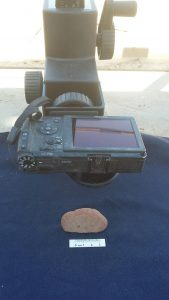I am delighted that the monograph AcrossBorders I, dedicated to SAV1 North, is now freely available online.
The main focus of the book published in the OREA series Contributions to the Archaeology of Egypt, Nubia and the Levant by the Austrian Academy of Science Press is the physical remains of SAV1 North: the architecture and material culture, with emphasis on the pottery and small finds.
Datable to the mid- to late 18th Dynasty, the building phase labelled as Level 3 was the heyday at sector SAV1 North, well-attested by several architectural remains with associated finds and pottery, which are all presented in the volume. A summary of thoughts on possible hints about the lifestyle and activities at SAV1 North preserved in the material remains completes AcrossBorders I. All in all, the evidence from SAV1 North underlines the important role Sai plays in understanding settlement patterns in New Kingdom Nubia.
Of course all of us are very much hoping that the openaccess version of the book will be widely used, especially by users without access to Egyptological/archaeological libraries!
Category Archives: Archaeology
Pottery, chronology and society in New Kingdom Sai, Sudan
Some brief thoughts about what ancient ceramics tell us about life in New Kingdom Nubia, using Sai Island as a case study, have just been published.
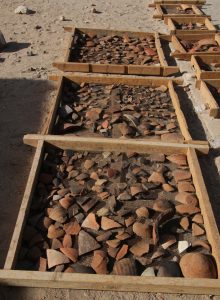 To access the full version of the article, please visit: www.scitecheuropa.eu/new-kingdom-pots-people/84560/
To access the full version of the article, please visit: www.scitecheuropa.eu/new-kingdom-pots-people/84560/
Article originally published on: www.scitecheuropa.eu/new-kingdom-pots-people/84560/
Reproduced by kind permission of Pan European Networks Ltd, www.scitecheuropa.eu/
© Pan European Networks 2018
Valentine’s Day Special: An exceptional heart scarab from Sai
Last year on Valentine’s Day, excavations in Tomb 26 on Sai were still ongoing. As Meg Gundlach put it back then “there are few things more romantic than a dung beetle”. Well – exactly! One year later, it’s again time to write about this very special heart scarab, SAC5 349, found next to the skeleton of chief goldsmith Khnummose. Let’s start with a spoiler: no, I still cannot read the name on the heart scarab, there is no complete love story to tell about Khnummose and his wife. But: my assumption that it is possibly the wife’s name on the scarab who was buried next to Khnummose at a slightly later moment still stands, although it remains hypothetical.
The heart scarab of Khnummose’s tomb group is an exceptional example also for other reasons. The general appearance of gold flakes and use of gold for the funerary equipment and jewellery in Tomb 26 is striking and seems to be connected with Khnummose’s profession. Very remarkable, among others, is this beautiful signet ring made of silver and gold found in Chamber 5.
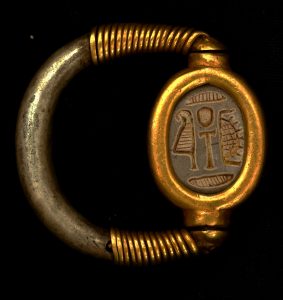 But coming back to the heart scarab: during the process of cleaning it in situ in Chamber 6, very fragile strips of gold came to light.
But coming back to the heart scarab: during the process of cleaning it in situ in Chamber 6, very fragile strips of gold came to light.
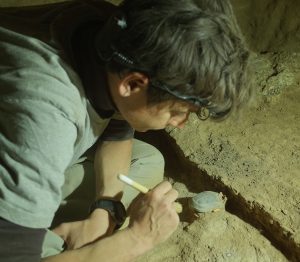 One piece was clearly attached around the base, other fragments where found close to the head of the scarab.
One piece was clearly attached around the base, other fragments where found close to the head of the scarab.
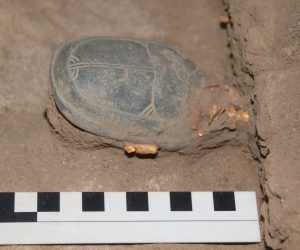 Possibly there were originally also gold bands across the elytra and at the division of the wing cases; this arrangement finds a close parallel in a Late New Kingdom example now kept at Liverpool – 1977.112.257 is a very nice heart scarab made of green jasper, it still has strips of gold attached.
Possibly there were originally also gold bands across the elytra and at the division of the wing cases; this arrangement finds a close parallel in a Late New Kingdom example now kept at Liverpool – 1977.112.257 is a very nice heart scarab made of green jasper, it still has strips of gold attached.
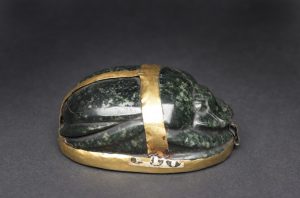
Heart scarab Liverpool 1977.112.257, http://www.liverpoolmuseums.org.uk/wml/collections/antiquities/ancient-egypt/item-317198.aspx
In general, such gold bands on heart scarabs of the New Kingdom are rare – for our example from Sai, I believe that they could attest to Khnummose’s job as chief goldsmith and to the general connection of the island to the gold exploitation in Nubia.
An update on Nun bowls from Sai Island
Back in 2015, Sabine Tschorn recorded all Nun bowl fragments from the New Kingdom town on Sai. This unique group of faience vessels is associated with regeneration and fertility and offers some insights into the daily life of 18th Dynasty Sai.
I am delighted that her analysis of the Nun bowls is now published (Tschorn 2017). In her paper, Sabine examines the excavated fragments and their distribution in the different sectors of the settlement as well as their diverse decorative motifs and functions. She is able to show that these faience vessels have to be seen in context with the architectural remains – for Sai, it is highly interesting that most fragments come from SAV1 North and SAV1 West, where a substantial amount of storage facilities and cellars was found, located close to the New Kingdom town wall. An association of the Nun bowls with ritual vessels like footed bowls for burning at both sectors might suggest a connection with offerings and libation. All in all, the function of Nun bowls in domestic settlements of the New Kingdom appears to be quite complex – once again stressing that daily life in ancient times also included various activities connected to the ritual and religious sphere (cf. Stevens 2006).
Thanks to the support of my FWF START project, the paper by Sabine has been published with full open access and will hopefully stimulate further research about an intriguing object group of the New Kingdom.
References
Stevens, A. 2006. Private Religion at Amarna. BAR International Series 1587. Oxford.
Tschorn, S. 2017. Nun-Schalen aus der Stadt des Neuen Reiches auf der Insel Sai, Ägypten und Levante 27, 431–446
New releases – some papers on Tomb 26 on Sai Island
Having just returned from Sudan and the student excursion, it’s very pleasant to find some new releases on one’s desk – especially because these also comprise papers highlightening the significance of Tomb 26 and especially of the burial of Khnummose on Sai Island.
 The following new articles are relevant for AcrossBorders’ work in cemetery SAC5:
The following new articles are relevant for AcrossBorders’ work in cemetery SAC5:
Budka, J., Pyramid cemetery SAC5, Sai Island, Northern Sudan: An update based on fieldwork from 2015–2017, Ägypten und Levante 27, 2017, 107‒130.
Budka, J., Das Grab eines Goldschmiedemeisters auf Sai in Obernubien, Sokar 35, 2017, 52-63.
Budka, J., The Tomb of a Master of Gold-workers on Sai Island, Ancient Egypt 18, No. 3, 2017/2018, 14-20.
Within the article published in Ägypten und Levante 27, I tried to reconstruct the complete use-life of Tomb 26, presenting for the first time preliminary results from the pottery analysis.
Please note that all of these articles still have to be regarded as “preliminary” – the final analysis, including the anthropological findings in Tomb 26 and the results from the Strontium Isotope analysis, is already well under way and will be published as another monograph in the series Contributions to the Archaeology of Egypt, Nubia and the Levant.
2017 in review
I should somehow check how many times within this blog I have used the phrase „time flies by “… but well – it indeed does!
2017 is almost history and this year was particularly important for AcrossBorders since we finished excavations at both sites, Sai Island and Elephantine Island – exactly as planned!
- In January 2017 we clarified that there are strata below the wall street in SAV1 West in the New Kingdom town of Sai – datable to the early 18th Dynasty!
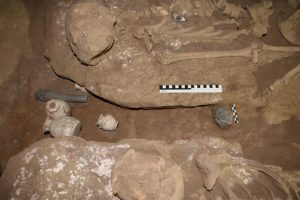
- In February 2017 we discovered the undisturbed burial of Khnummes and his presumed wife in Tomb 26!
- In March 2017 two large cellars, one with still intact vault ceiling, were unearthed in SAV1 East in the New Kingdom town of Sai!
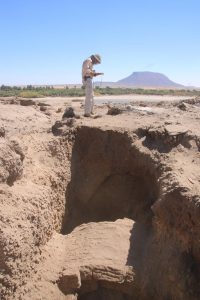
- April was somehow a short break – back to Munich and Vienna again… teaching term started…
- In May 2017 I could present the lasted findings on Sai at the SARS meeting in London – the Sudan & Nubia volume is now already published!

- In June 2017 we conducted some experiments within the framework of the practical class experimental archaeology.
- In July 2017 I tried to get some written work done… and processing of finds and pottery continued…
- In August 2017 the first monograph of the series dedicated to AcrossBorders’s work on Sai was published in Vienna – AcrossBorders I, hurray!
- In September 2017, a wonderful closing conference took place in Munich – thanks again to all participants!
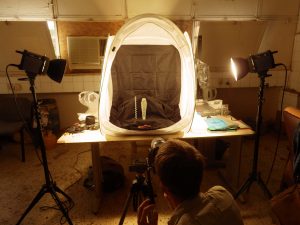
- In October 2017, we were busy working in Khartoum on the objects now stored in the National Museum – and later in the month, started our Elephantine season!
- In November 2017, we finished the excavation in House 55 on Elephantine, including a complete documention of the building for image based modelling! And late in the month, an interdisciplinary workshop was held in Vienna, in cooperation with the Young Academy at the Austrian Academy of Sciences. Our guest of honour was Dr. Abdelrahman Ali Mohammed, General Director of NCAM.
The workshop was closed with a book presentation – AcrossBorders I and also Ingrid Adenstedt’s book on the 3D reconstruction of the New Kingdom town were introduced – very proud to publish with OREA and at the Austrian Academy!
- In December 2017, processing continued and formatting of the first papers of the AcrossBorders conference from September started – the volume will be out by summer 2018 insha’allah.
With four more months to go before AcrossBorders officially ends in April 2018, timing will be as dense but for sure also as productive like during the complete 2017 year – many thanks here to all our collaborators, supporters and team members.
Wishing all of our friends, colleagues and readers very happy holidays and a perfect start into 2018! I’ll be off to an excursion to Sudan with students from LMU soon – guaranteeing that my personal start into the New Year will be simply impeccable, or, as we say in Vienna: “urleiwand”.
Showcasing settlement archaeology in Egypt and Nubia
The last 5 years have been really busy – with fieldwork at Sai and Elephantine, AcrossBorders has illustrated the rich potential of modern settlement archaeology, taking advantage of recent developments in archaeometry and other interdisciplinary fields.
Results from micromorphology, geology, isotope analysis and archaeometry of ceramics and other materials provide much food for thought and illustrate the complex entanglement of cultures in New Kingdom Nubia. Cooking pots are among the most interesting findings as I have just outlined in a German blog post for the Young Academy on derStandard.at.
The closing of the AcrossBorders project is already approaching – to celebrate its success, an interdisciplinary workshop with most of our cooperation partners and many team members will take place next week in Vienna. Hoping for a fruitful discussion of possible future developments related to settlement archaeology in Egypt and Sudan, I am very much looking forward to this event.
Winter in Egypt, week 3 at Elephantine
Having had a very pleasant visit from Friends of the Egyptian Museum in Munich today, I was just reminded that actually winter has arrived in Europe… Someone told me that it’s even supposed to snow in Munich early next week – well, I’d better not think to much about this… Anyway, I thought I share some pictures of the beauty of Aswan, especially for all of you who are not enjoying the very nice weather here in Egypt!
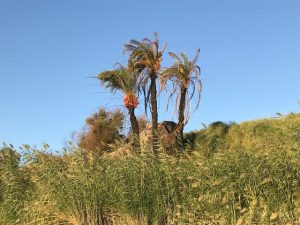
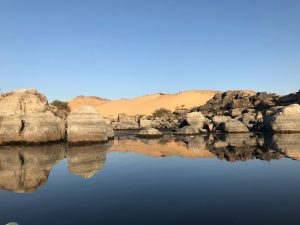 Week 3 just started, some more days to go before I have to head back to Munich (and will face real winter after all…). We are still focusing on Nubian wares and other pottery vessels; Oliver will be concentrating on pots from the early phases of use of House 55 this week. Lucia has already produced wonderful drawings of the numerous net weights and will continue with female figurines in the next days. Daniela is busy polishing the database and completing some entries. Making very good progress, more to come!
Week 3 just started, some more days to go before I have to head back to Munich (and will face real winter after all…). We are still focusing on Nubian wares and other pottery vessels; Oliver will be concentrating on pots from the early phases of use of House 55 this week. Lucia has already produced wonderful drawings of the numerous net weights and will continue with female figurines in the next days. Daniela is busy polishing the database and completing some entries. Making very good progress, more to come!
Nubian wares of House 55
This working week at Elephantine just flew by… I am back concentrating on another of my favorite topics within the intriguing House 55: the Nubian wares, comprising both fine wares and household wares, including drinking, serving and storage vessels as well as abundant cooking pots.
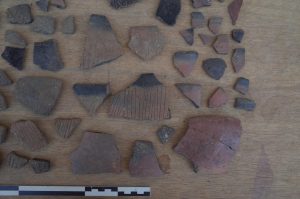 Most fascinating about the considerable assemblage of Nubian wares is besides the broad spectrum of forms and types that we find them in all levels of use of House 55 – thus, they are not restricted to the earliest phases from the 17th Dynasty and very early 18th Dynasty, but continue well into Thutmoside times. This also holds true for Kerma Black topped fine ware which is in particular of special importance – and of particular interest for us as we find good parallels in the New Kingdom town of Sai and AcrossBorders’ most recent works there.
Most fascinating about the considerable assemblage of Nubian wares is besides the broad spectrum of forms and types that we find them in all levels of use of House 55 – thus, they are not restricted to the earliest phases from the 17th Dynasty and very early 18th Dynasty, but continue well into Thutmoside times. This also holds true for Kerma Black topped fine ware which is in particular of special importance – and of particular interest for us as we find good parallels in the New Kingdom town of Sai and AcrossBorders’ most recent works there.
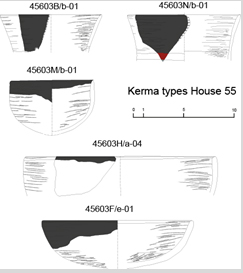 My database currently holds 222 Nubian vessels from House 55 – 29 are Black topped fine wares, the well-known beakers, but also dishes, and small cups. Three more boxes full of Nubian sherds are still waiting to be documented, so these numbers will definitely increase in the next days. Detailed statistics and assessments of course have to wait until the very end, but the prospects are already really exciting!
My database currently holds 222 Nubian vessels from House 55 – 29 are Black topped fine wares, the well-known beakers, but also dishes, and small cups. Three more boxes full of Nubian sherds are still waiting to be documented, so these numbers will definitely increase in the next days. Detailed statistics and assessments of course have to wait until the very end, but the prospects are already really exciting!
Start of week 2 on Elephantine
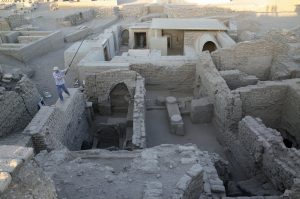 It’s almost unbelievable – after four busy years, the excavations in House 55 on Elephantine are really finished! Today, Martin Fera took some last photos with the most recent details, including a newly emptied silo, to be added for the image based modelling of the complete building. Documentation will now focus on ceramics and finds – and the aim is, to have an overview at the end of the season of all materials.
It’s almost unbelievable – after four busy years, the excavations in House 55 on Elephantine are really finished! Today, Martin Fera took some last photos with the most recent details, including a newly emptied silo, to be added for the image based modelling of the complete building. Documentation will now focus on ceramics and finds – and the aim is, to have an overview at the end of the season of all materials.
The pottery is already well assessed – more drawings and photos will be produced, but with 2000 vessels in the database, the record is now very strong and representative.
The small finds will still keep us busy for a while – currently c. 3600 objects are in the database, but more are still waiting to be recorded. Today, I focused on some re-used sherds which are attested in a very high number. I am in particular interested in the various types of net weights. Most common in House 55 is type C in the classification by Cornelius von Pilgrim (1996). Currently, 64 net weights were recorded and except for one, all fall into this type. The single other weight is type A, the so-called axe-shape type.
This dominance of type C net weights, mostly produced from Marl C and Marl A4 sherds, is striking – in particular in comparison with Sai Island. As outlined earlier, type C is quite rare in the new Kingdom town of Sai and definitely outnumbered by type A.
In 2013, I was still very unsecure about the interpretation of this difference – with little material excavated on Sai back then, all might have been accidental. But after five seasons on Sai and four seasons of work on House 44, it is now clear that the original line of interpretation is the most likely one, based on a large set of data from both sites.
As von Pilgrim has proposed (von Pilgrim 1996, 275–278) type C, recycled from pottery sherds, seems to represent the ad hoc product for individual needs. The distribution of net weights at Sai was probably organized at a more formal level than in Elephantine, with imported net weights of type A and only rare cases of versions from re-used sherds. A “centralized system of food production” as reflected in the use of net weights of type A was already suggested by Smith for the Middle Kingdom phase at Askut (Smith 2003, 101) and seems to be supported by the evidence from Sai in close comparison with Elephantine.
Tomorrow will be another busy day, full of net weights, sherds and other interesting traces of activities on 18th Dynasty Elephantine!
References
von Pilgrim 1996 = C. von Pilgrim, Elephantine XVIII. Untersuchungen in der Stadt des Mittleren Reiches und des Zweiten Zwischenzeit, AV 91, Mainz am Rhein 1996.
Smith 2003 = St. T. Smith, Wretched Kush. Ethnic identities and boundaries in Egypt’s Nubian Empire, London and New York 2003.



